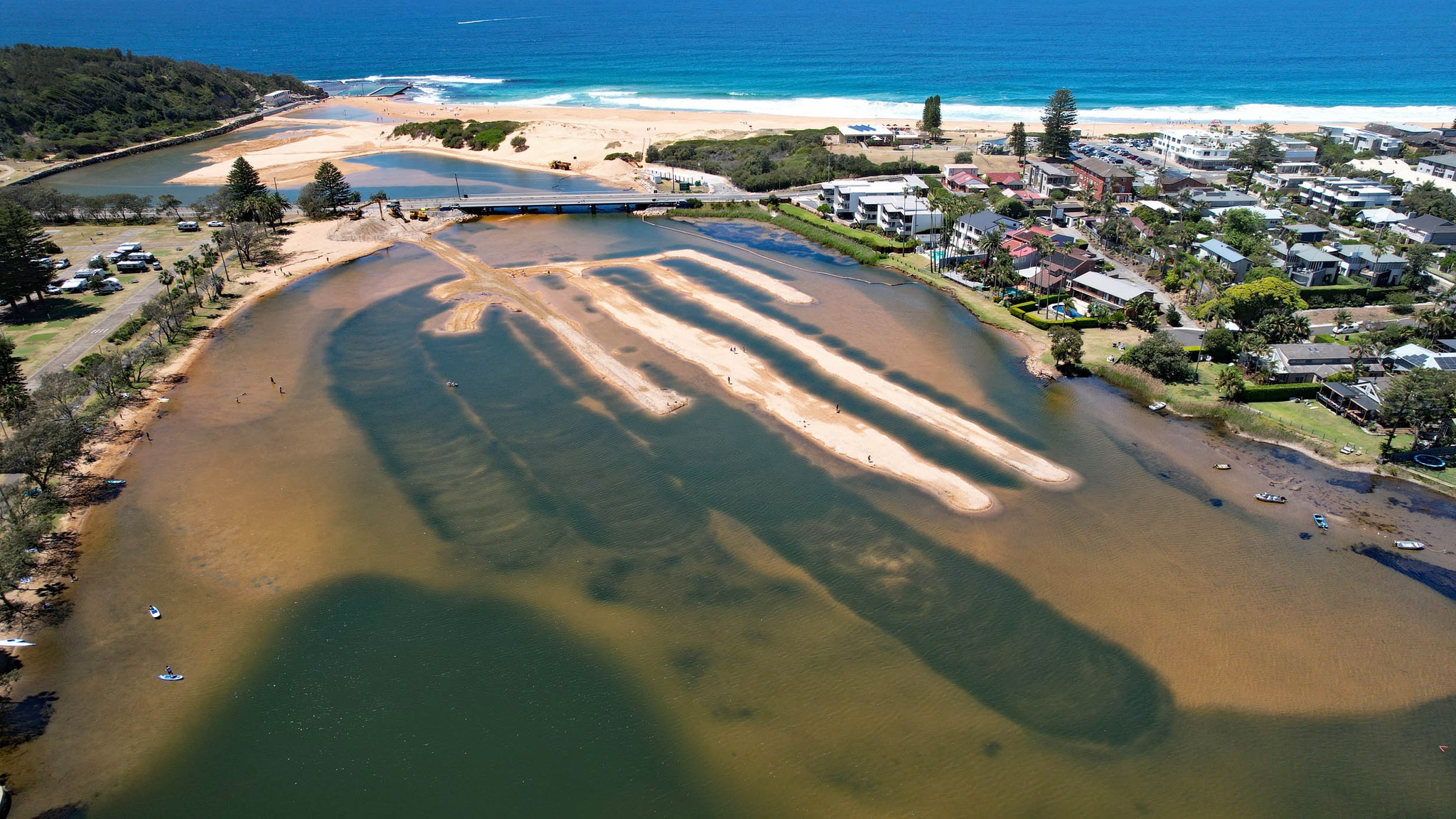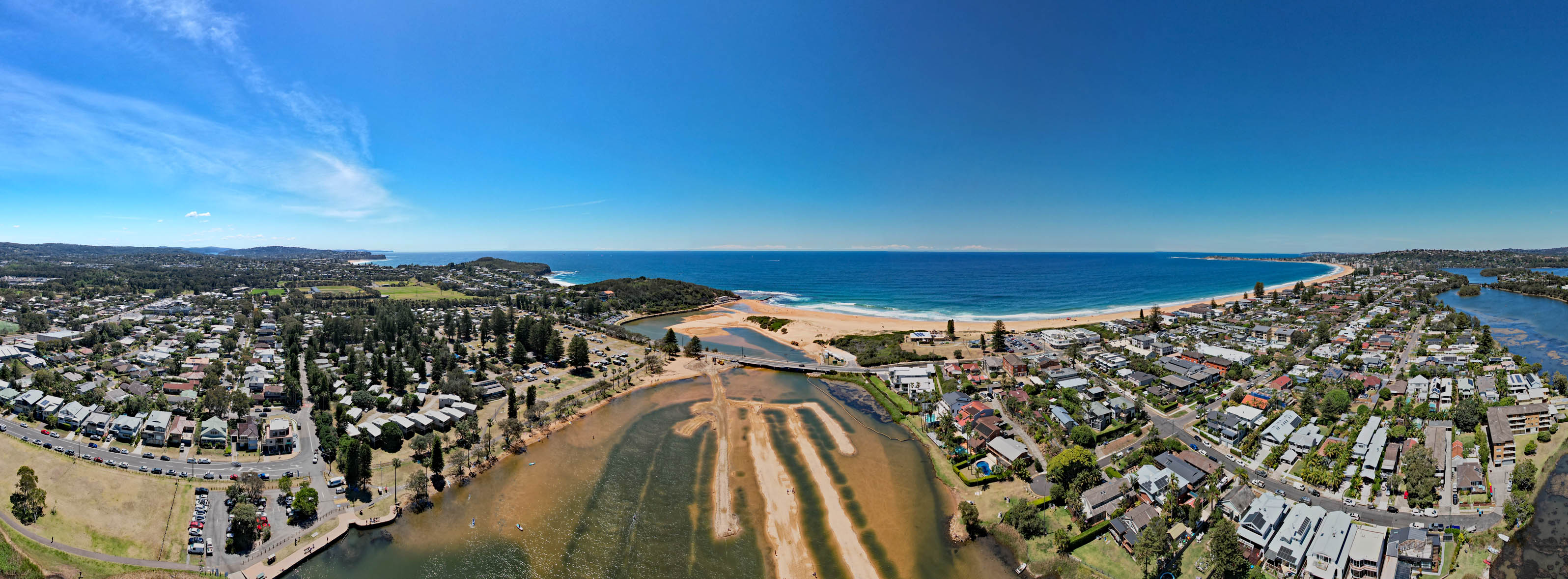November 19 - 25, 2023: Issue 606
John Grainger
Photographer
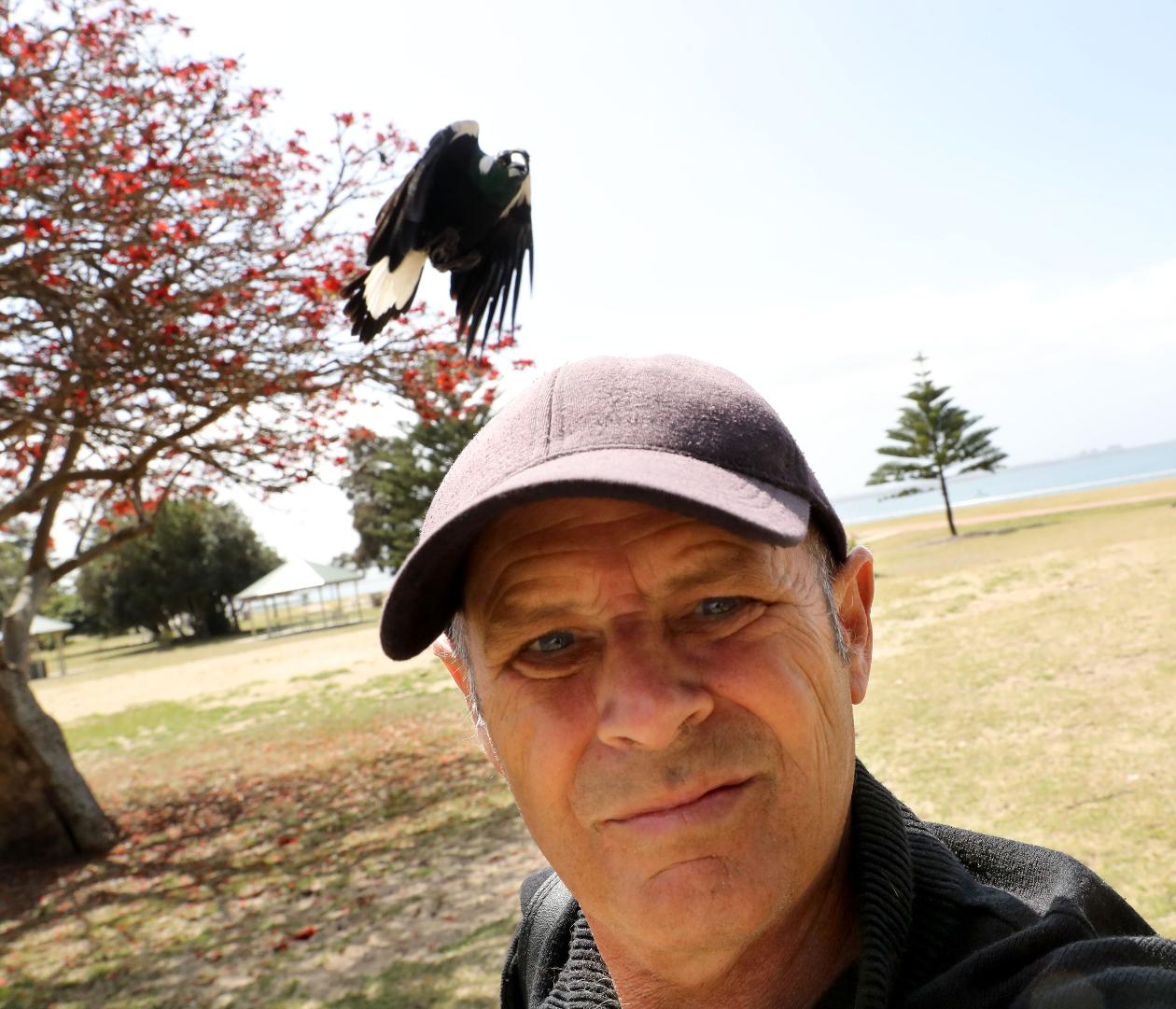
For those looking for something special or unique as a gift for those who live here or those far from home this Christmas, or for any other occasion, local former Press Photographer John Grainger may have that weather, landscape or wildlife image you’re looking for.
John has been covering news on the peninsula from the 1980s’ but still gets out and about capturing local weather, events and other happenings as Photography is a passion for him, not a former career choice or a long term pastime.
John has been a news photographer for 30 + years, although every so often he will turn to something else. He's dabbled in Panoramic (on Film), had exhibitions and dived into Macro Photography, recently looking into the patterns, texture and structure of Butterflies and Moths, focused Australian species when he can get them. John also chases weather for the unusual cloud formations.
You can see his work at:
Instagram page: @jag2101
J Grainger Photography - Available at: riptideprints.com/collections/j-grainger
Photographs by John Grainger - At: www.facebook.com/profile.
Catalogue of photographic prints by multi-award winning photographer John Grainger
These can be made to order on Canvas. John has nearly 200 images.
Something New & Unique. Macro Photographs of Moth & butterfly wings most are found in Australia.
As a Press Photographer John has experienced some true 'Boys Own Adventure' stuff and been able to go to places and see things most will not - but he took a picture for everyone else to be there too; that was his job.
There's an opposite to all that gloriousness though.
Most Readers would be aware by now of the phrases 'if it bleeds it leads' or a focus by some news outlets on what is termed 'clickbait' in the modern world. Why do they do it?: put simply, this translates into huge economical returns for news outlets that focus on such stories. Monitoring police, fire and ambulance scanners and running images of your neighbours dying on the pavement down the road after a car accident, or family members crying at the funeral of a child they have lost in horrific circumstances, generates huge profits.
Ditto stories focused on titillation and scintillation - people can view without being involved, judge without being connected, condemn those who run them without casting an eye over their own past indiscretions.
But what kind of impact does this have on the reporters working under such policies? Journalists leaving publications due to their running misleading stories, 'misinformation', has become the norm. In Australia we've witnessed journalists leaving papers because they ran campaigns for years against climate change existing. In the US as we go to press former Fox News Capitol Hill reporter and producer Jason Donner has sued the network, claiming he was fired for challenging its on-air lies about the 2020 election. Mr. Donner alleges in the lawsuit that Fox News knew Donald Trump's claims that voter fraud was behind his 2020 loss were false but that following backlash from Trump and the network's audience over its Election Day announcement that President Joe Biden had won Arizona, it "purged" journalists who spoke out against false election fraud claims.
"To win back viewership and pledge its loyalty to President Trump, Fox’s corporate leadership purged the news division and those reporters who spoke out against claims of election fraud," says the suit. The wrongful termination and discrimination claim seeks undisclosed damages and expenses, as well as a judgment that would prohibit Fox News from discriminating or retaliating against Donner or other current or former Fox News employees.
There are reports available of how breaking traumatic news stories impact on journalists and press photographers leading to them to leave the industry, with some dealing with PTSD thereafter. Not so well known are the assaults on journalists and photographers, although people are now more aware of how presenters are trolled online or their private lives become a 'news story' to try and get them out of where they are being heard - the ABC's Stan Grant and Patricia Karvelas are just two examples from this year alone.
Anyone who has screamed at a television screen to 'just stop taking the pictures and get those children out of there' would know there is always a conflict between doing the job and doing something else when in those situations.
The role of the photographer is to bear witness.
In his work as a Press Photographer for The Daily Telegraph John is a multi-award winner. In August 2022 he won the Kennedy Award for Outstanding News Photography for his image of newly-elected Prime Minister Anthony Albanese on an early morning foray from his front door wearing a Newtown Jets footy jersey and some serious bed hair. John won the same award in 2018 too. The Kennedy Awards is a national media awards program. Entry is open to all Australian working journalists, cartoonists, camera operators and videographers.
John's former work also underlines that without the picture there is no story.
His photo of a heavily pregnant Vikki Campion, now Mrs. Barnaby Joyce, won a 2018 Walkley Award for Tele journalists for the ‘Bundle of Joyce’ article in the Scoop of the Year category. In August 2020 Barnaby Joyce, in speaking about the conflict between media and a right to privacy on the ABC's Q&A, said “I’m in the public, I’m paid for a job – but if a person is an individual that is not paid, then it is not in the public interest,” he said. “I’m going to call it out because I don’t care, that’s all in the past what happened to me. I don’t want that to happen to somebody in the future.”
The picture and accompanying story disclosed the pair were having a child. This ran just months after Mr Joyce confirmed the breakdown of his 24-year marriage to his now ex-wife. Mr Joyce faced intense scrutiny after the picture was published, especially over the fact he used “family values” as one of his reasons for being a staunch opponent of same-sex marriage. He subsequently stepped down as deputy prime minister.
Journalist Sharri Markson later defended publishing it as in the public interest despite it making her feel “uncomfortable.”
The Walkley judges comments were:
'A genuine scoop accompanied by an iconic headline and “gotcha” photograph. “Bundle of Joyce” would bring down a deputy prime minister and result in a ban on ministers having relationships with staffers. Right across the nation talk of office romances and family values was dominating water coolers and dinner tables.'
It's no secret that complaints about News Corp Australia publications stories feature heavily in complaints to the Australian Press Council.
However, John's photographs have helped change what needs to be changed in our society to keep people safer, shift discussions and honour the credo in what became known as the Fourth Estate.
The idea embedded in the fourth estate is that the media’s function is to act as a guardian of the public interest and as a watchdog on the activities of government. Depending on one’s view of the media, this is either self-serving rationalisation, or an important component of the checks and balances that form part of a modern democracy.
A nation’s ability to have a healthy strong press that simply runs ‘what is’ allows citizens to make their own minds up. In places where a free press is absent so is your ability to find out what is going on and speak out against corruption or a dictator. In some nations it is illegal to run anything opposed to those in power - people who do are gaoled, even executed.
The emphasis for a good news service is on being able to educate, inform and entertain through news, features and analysis in the press. A good news service provides a platform for the voices of those who consider themselves to be voiceless to be heard; it supports and creates public debate.
News services will also work together to give communities a voice. A journalist from one news service will contact a journalist they know working for another news organisation and let them know about a story when local community residents ask for their help in 'getting the story out'.
The term Fourth Estate refers to the press and news media both in explicit capacity of advocacy and implicit ability to frame political issues. While the Constitution established the executive, legislative and judicial branches, the phrase “Fourth Estate” reflects the unofficial but widely accepted role the news media play in providing citizens with information they can use to check government power and any other issue which impacts our lives and the planet.
Without this, and a ‘freedom of the press’, citizens have only the narrative run by the incumbents and opposition, termed 'spin'. Without the research and investigation that goes into presenting a report, and what that research brings in terms of what is found; objectivity and accuracy in news reporting, the Press’ role in our society is undermined.
From the outset this too was subject to the agenda of those owning these portals of the fourth estate. There are two primary areas of media agenda-setting: (i) the media tells us the news and (ii) the media tells us what to think about the news. Press coverage sends signals to audiences about the importance of mentioned issues, while framing the news induces the unsuspecting viewer into a particular response.
This shows in the statistics - News Corps' news.com.au ranked number 1 with just over 12 million visitors each month as the most visited News & Media Publishers website in Australia in October 2023, followed by abc.net.au with over 10 million visitors, and yahoo.com ranking at 3rd place as the leaders of the News & Media Publishers websites in Australia.
On August 10 2023 News Corp announced Fourth quarter revenues were $2.43 billion, compared to $2.67 billion in the prior year. Net loss in the quarter was $(32) million, inclusive of $166 million related to higher non-cash write-downs and restructuring charges, compared to net income of $127 million in the prior year, which included a $149 million tax benefit. Fourth quarter Total Segment EBITDA was $341 million, compared to $315 million in the prior year.
Digital revenues accounted for over 50% of total revenues for the full year, marking a key inflection point in the transformation of the Company.
Commenting on the results, Chief Executive Robert Thomson said:
“News Corp’s Fiscal 2023 results highlighted the durability and depth of our revenue streams and the impact of stringent cost controls as we navigated challenging macro conditions, supply chain pressures and currency headwinds. We achieved full year Fiscal 2023 revenues of $9.9 billion and profits of over $1.4 billion – the second highest profitability ever recorded by the Company. Our results showed marked improvement in the second half, so with inflation abating, interest rates plateauing and incipient signs of stability in the housing market, we have sound reasons for optimism about the coming quarters.
For the first time, digital accounted for over 50% of News Corp’s revenues for the full year, marking a profound transformation during the past decade. That momentum is surely gathering pace in the age of generative AI, which we believe presents a remarkable opportunity to create a new stream of revenues, while allowing us to reduce costs across the business. We are already in active negotiations to establish a value for our unique content sets and IP that will play a crucial role in the future of AI.'
Digital subscribers at News Corp Australia as of June 30, 2023 were 1,059,000 (943,000 for news mastheads), compared to 964,000 (882,000 for news mastheads) in the prior year.
That here in Australia a news company that focuses on 'hits' has direct competition from the ABC, with a remit of being a publicly funded, independent media organisation that hosts such platforms as the RMIT Fact Check, would indicate Australians are not so easily fooled and prefer in depth coverage that presents all sides of a subject as much as they will resort to clickbait from ambulance chasing, posing with a visiting celebrity publicity seekers.
However, Photography is one of the area that can remain free of that guff as the remit is to capture the essence of what is going on.
As a Photographer for News Corp Australia John's photos featured on the Front Page of the Daily Telegraph. His captures have inspired, outraged, endeared, and celebrated whatever subject he was capturing.
As a Press Photographer your job is to take photographs to record news, current events and lifestyle stories. Your aim is to capture the best images to document an event, tell a story or convey a message and support the printed word. A great Press Photographer will go beyond that remit and have what is termed an ‘instinct’ for what is about to happen and how to position themselves to get the shot. They go beyond the ‘a picture is worth a thousand words’.
Nicholas Moir, another legend in the news photography sphere, had high praise for John, stating on August 31 2023;
‘’Today John Grainger leaves the Daily Telegraph, after what must be a couple of Centuries.
I have worked as John’s opposition at the SMH for over 20 years. I think our first good chat was when we both saw the same great pic of the Ansett sign being ripped down out the front of the airport as the airline collapsed. Unfortunately, that was September 11, 2001 so let’s just say we both lost the front page that day.
He is hands down, one of the most difficult photographers I’ve ever had to compete against as his knowledge of Sydney breaking news, the people involved and how the story will evolve is exceptional. His skill forced me to always be thinking about the next move, the next image. We have spent thousands of hours having to watch each others backs from fires, floods, murders and brutal thugs. I’ll also miss having somebody who would be professional enough get a great frame of me getting beaten up. All the best John!’’
This week a celebration of the long and varied career of a local Press photographer for those who remember his work and to inspire those who want to work professionally as a News Photographer.
Where did your love of photography start – what was your first camera?
I think it was one of those instamatics you get as a kid.
When did you start taking photos for others?
Probably 1986, when I went overseas. I went to Japan, England and America and started taking photos along the way. When I got back I had a friend process them who said ‘maybe you should get into photography’. So I started from there.
How did you get into news photography?
I just started chasing ambulances basically, using scanners, worked all that out. In that way I could start building up a portfolio to get a job in the media.
If anyone wants to get into this sort of work, be prepared to lose your social life. If you really truly have the hunger for news then you will be on it 24/7. You have to be prepared to go where and when it’s happening. These days it’s a bit different – you can listen to scanners for firies and ambos, but not the police. It depends on how hard to you want to chase it – you need to know the law inside out, so when you’re confronted by a nasty policeperson you can get the job done.
Aren’t they trying to protect you from getting hurt when attending those scenes?
No, they’re not. They may claim that, but that’s not it.
If you really really want to get into this stuff join your local SES, join your local RFS, join your local clubs and in that way you will find new leads everywhere.
You can walk down the street and find a lead; you will find a story. They used to let me run riot through the city and I’d always come back with a story.
What was the first job you got?
The first paid job in the media was at a lace called the Northern Beaches Weekender, which has gone now, but was owned then by Torch.
What genre of shots were you getting for them?
I was doing everything in there, from Real Estate to hard news to cheque presentations, everything.
You then moved on to News Corp and working for the Daily Telegraph for over two decades?
Yep.
Nicholas Moir gave your work high praise earlier this year. When was your last day working for the Tele?
My last actual working day was the bus accident up at the Hunter Valley. That was horrific, it really was.
From there I just saw how the media were reacting and for me it was a case of ‘oh my God’, and ‘why am I doing this?’
There were other things happening too – I had a year of stuff happening that made me reassess what I was doing.
You have obviously had to attend some horrific scenes during your career – how does that impact on you personally?
I never thought it did. During that year I was seeing doctors and specialists because things just weren’t right. That never bothered me, seeing deceased people, attending accidents – it wasn’t that, it was afterwards, dealing with the work. You have to be pretty thick-skinned really, to do that work.
On the obverse, what were the best things you photographed as part of the work?
I got to fly to the Solomon Islands with the Prime Minister on his jet.
Which Prime Minister?
Howard.
Which shot from that trip?
I got the photo of him holding a pistol. That went a bit wild.
Any others?
The big hard news stories where you get an exclusive picture are quite good because everyone else just goes ‘how do you do that?’.
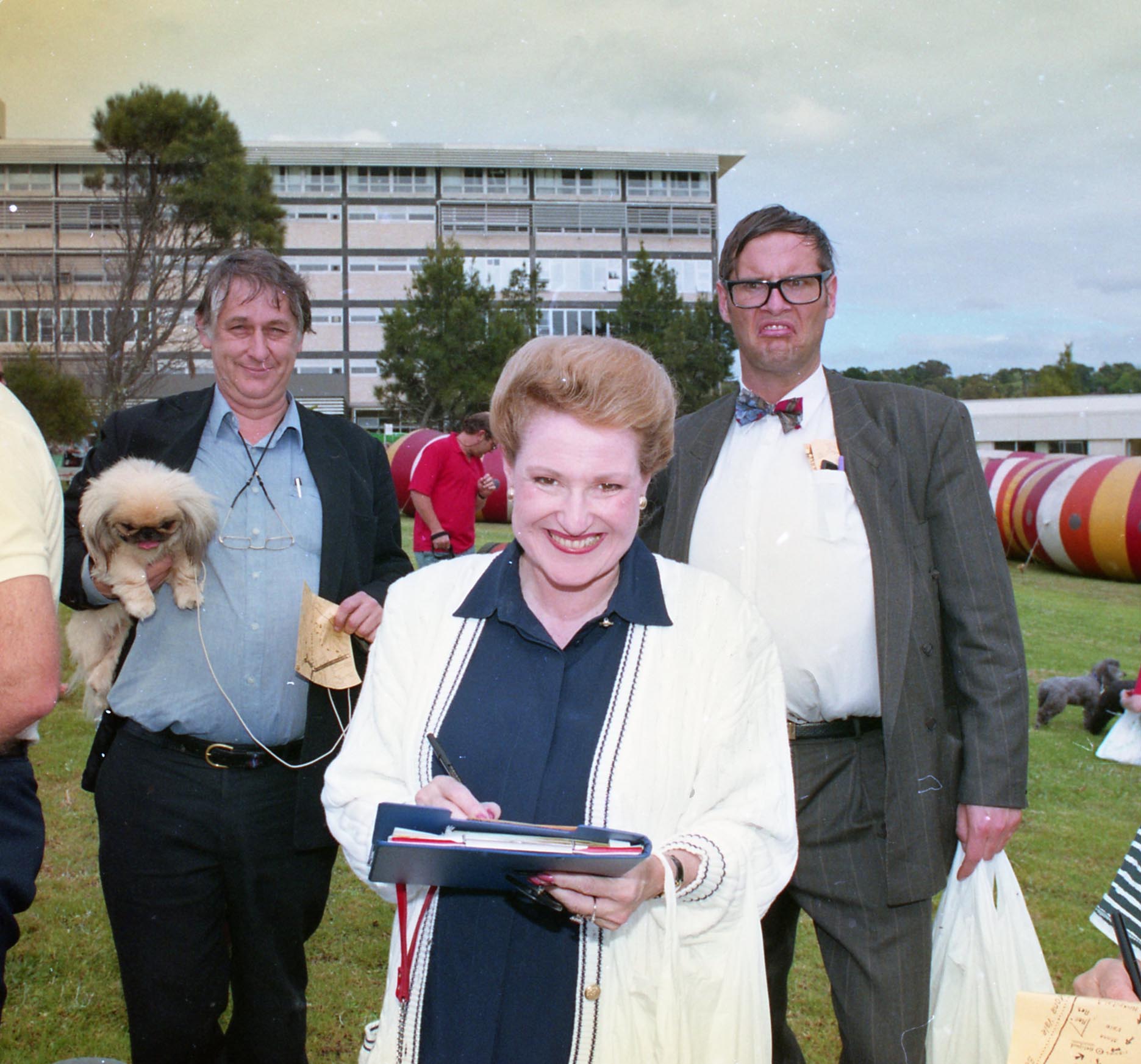
Bob Ellis, Godfrey Bigot** and Bronwyn Bishop in 1993. Photo: John Grainger
Pursuit and arrest at gunpoint on Mona Vale rd, 2002. Photo: John Grainger
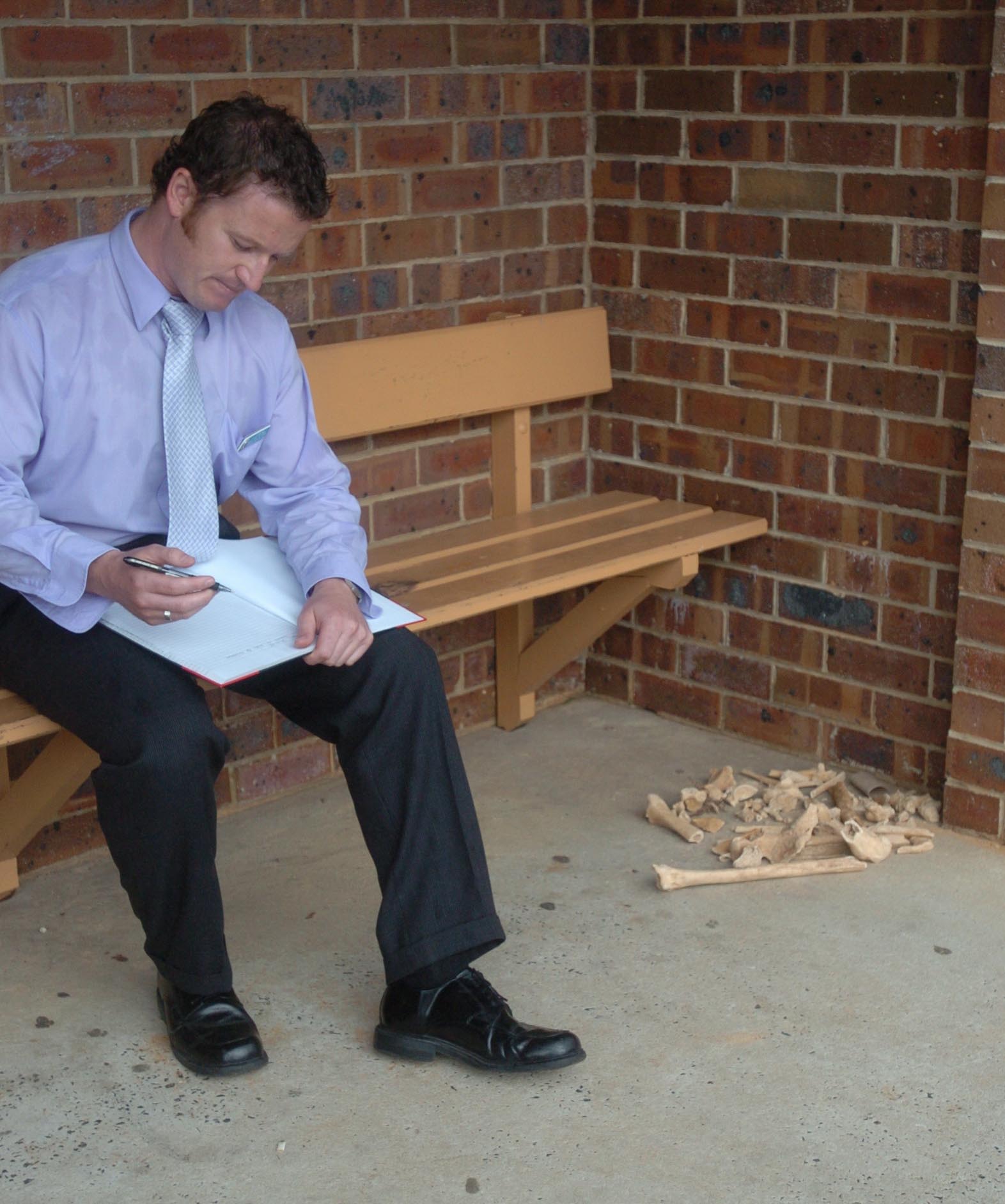
Bones Ocean st, Narrabeen. Now known as the Narrabeen Man 20-1-05. Photo: John Grainger
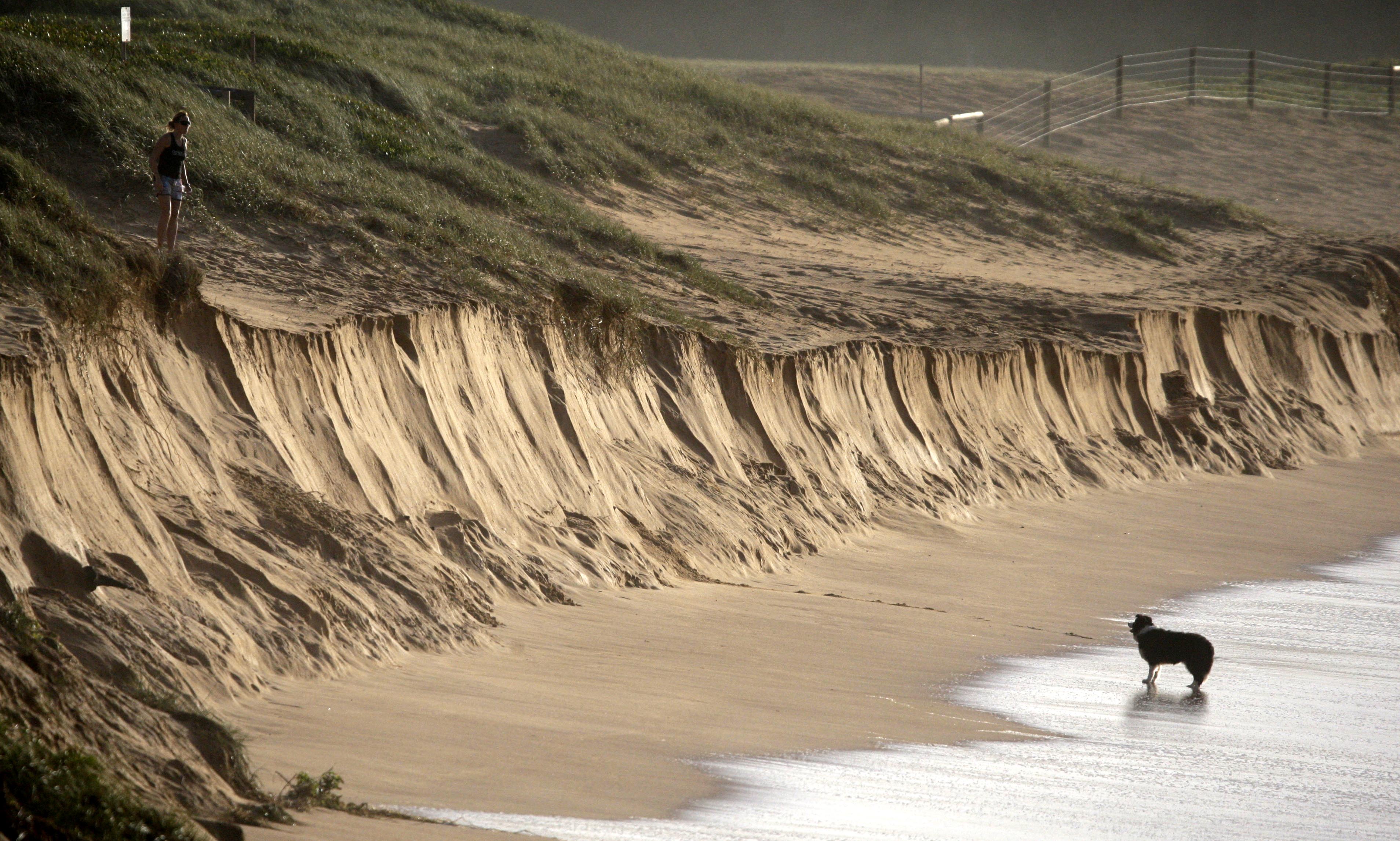
Erosion at Narrabeen, 2009. Photo: John Grainger
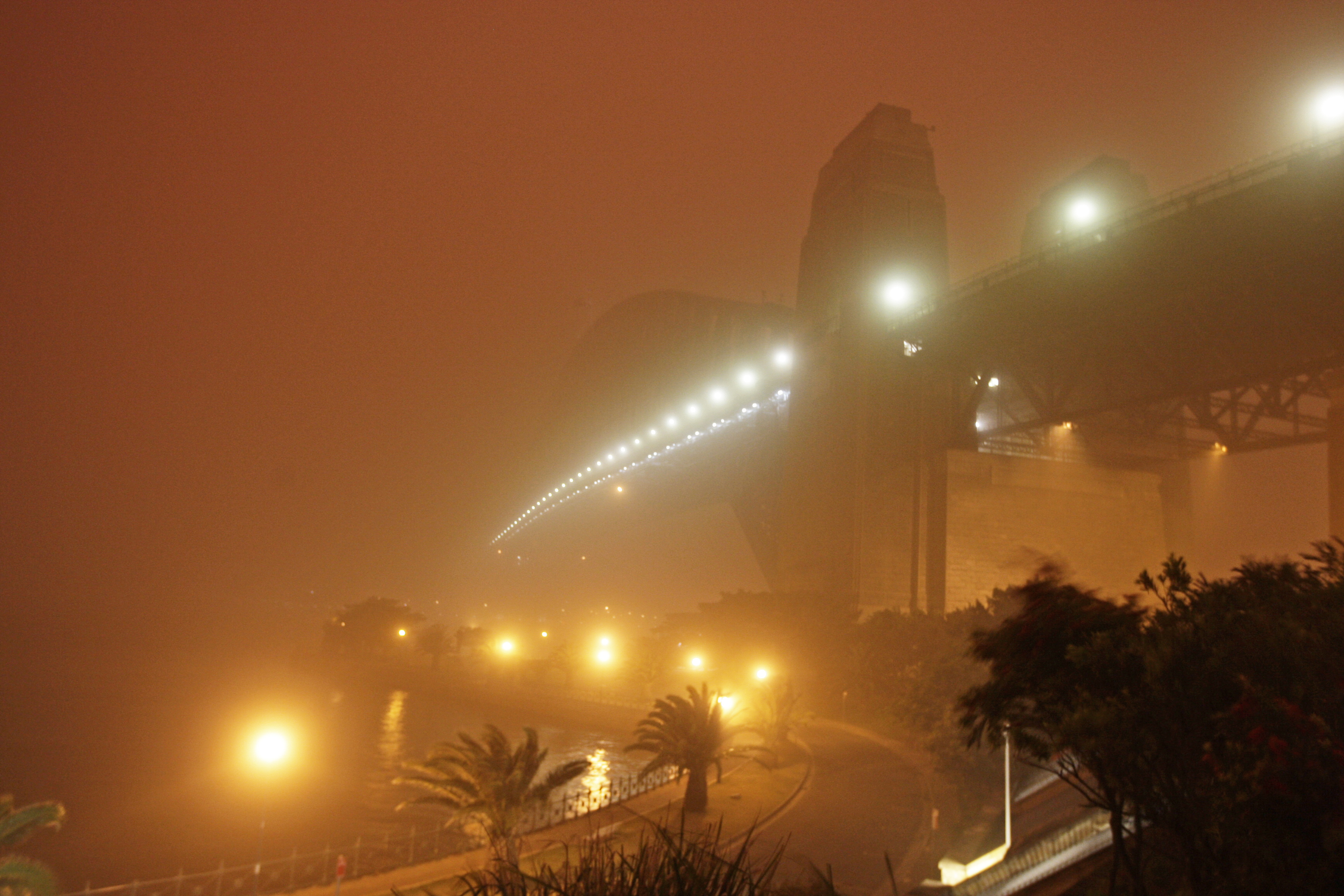
Dust Storm, 2009. Photo: John Grainger
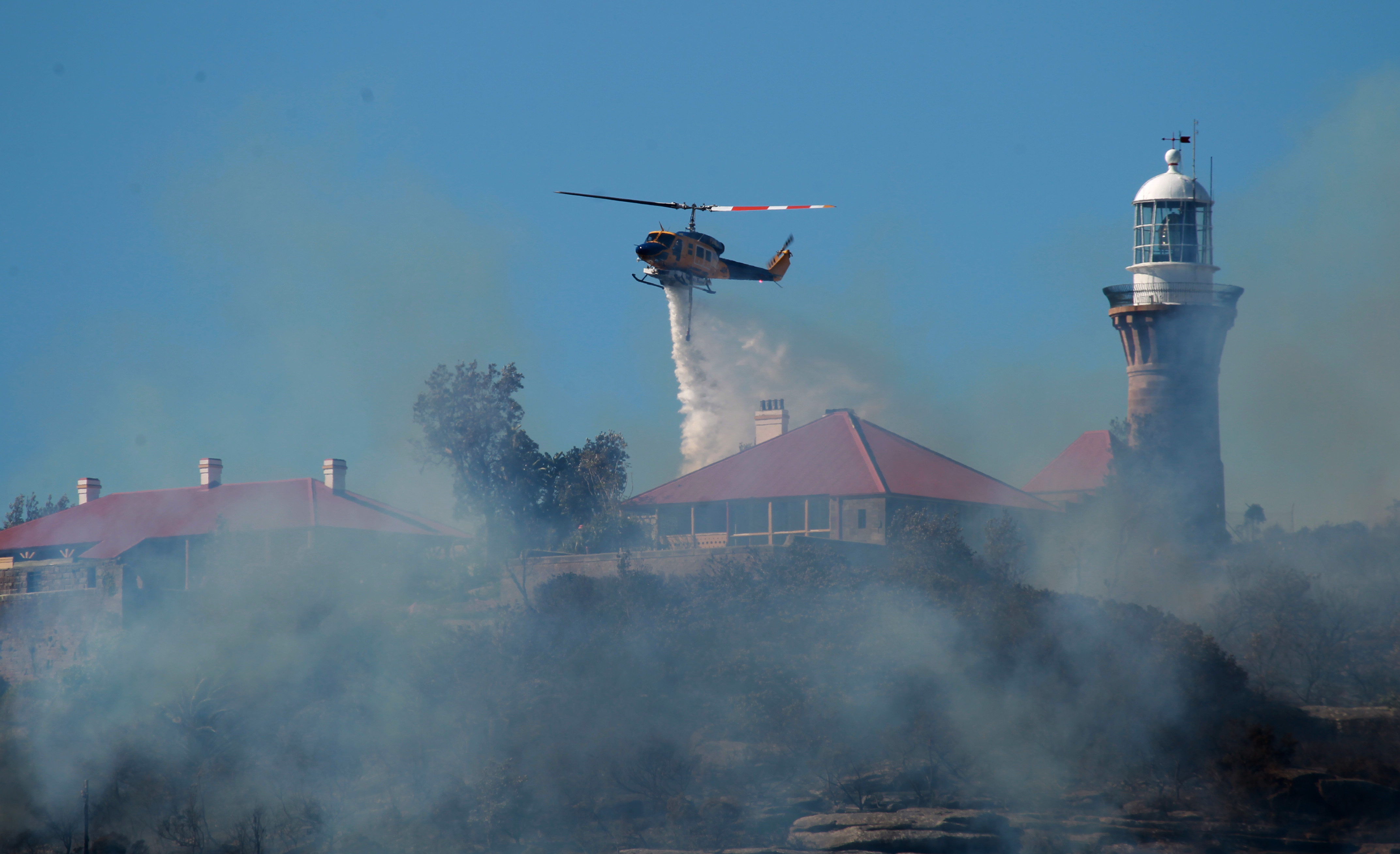
Water bombing Palm Beach Headland during that 2013 fire. Photo: John Grainger
What did you enjoy getting the most?
My favourite stuff is weather. I chase weather too. It’s dramatic – if you have ever been in a big storm, watching to develop and what it does, the damage it can cause, it’s quite amazing. I always enjoy weather.
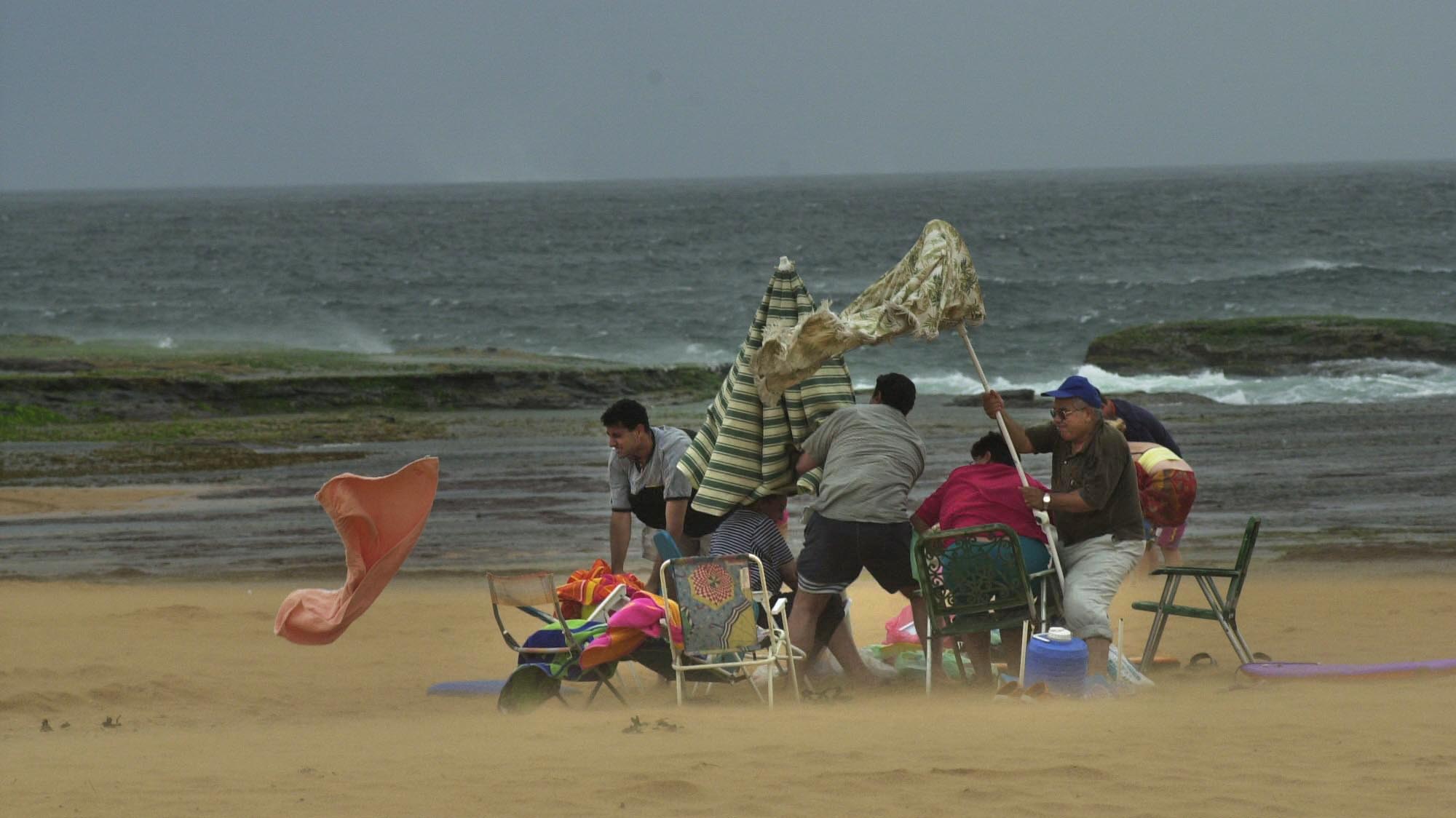
A family at Mona Vale didn't see the warning signs as a Southerly Buster smashes them, 2003. Photo: John Grainger
One of the best jobs they gave me was to ‘go out to Richmond, get in a Hercules, these planes are going to be decommissioned, you’re going to be taken for a flight over Sydney, get whatever you can’.
(laughs) So they opened up the back and I got to hang out the back and photograph another plane following us dong certain manoeuvres over the Harbour Bridge. That went really big.
I made everyone in the other plane sick because I had control. (laughs). Everybody got sick they said.
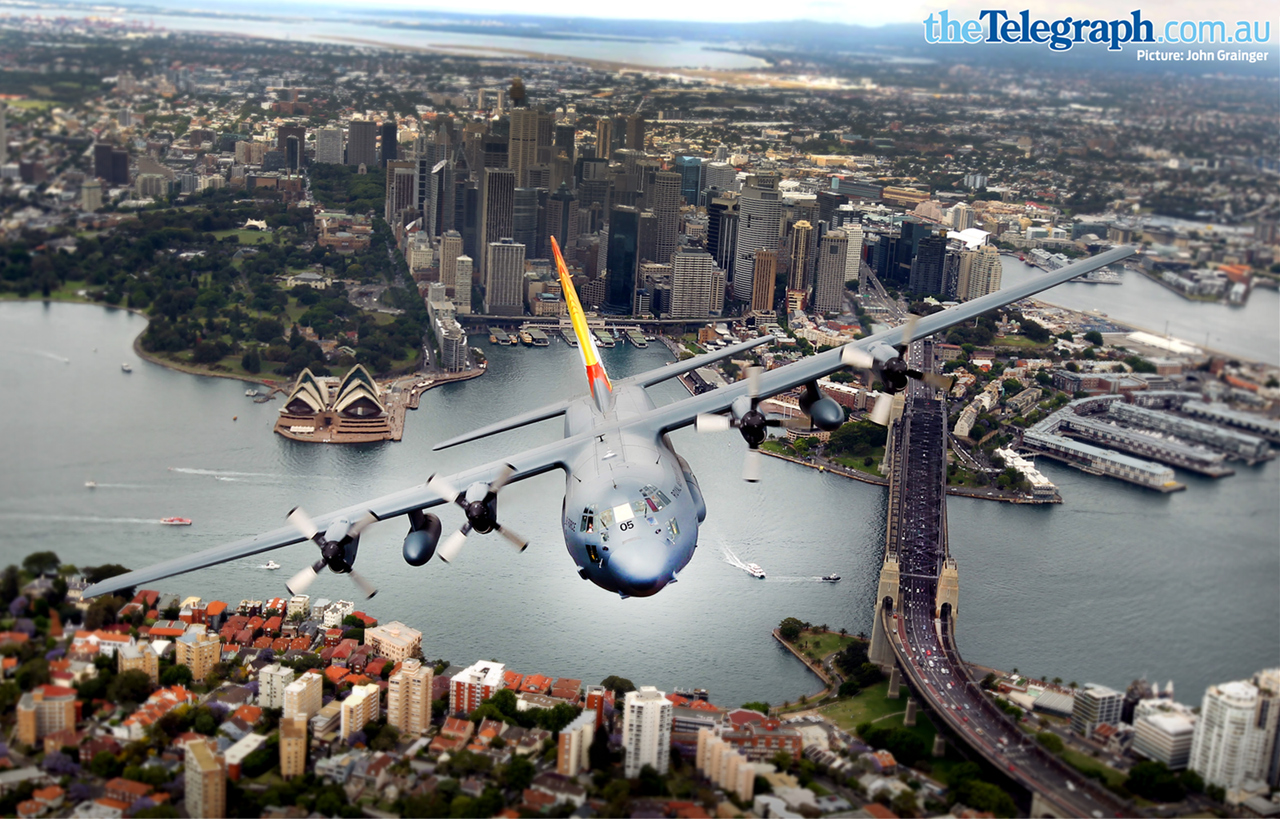
This is real boys own adventure stuff?
It is. I’ve been in the nuclear reactor at Lucas Heights; I’ve looked into the pool there – no one gets to do that - been on top of the Sydney Tower, been on top of the Sydney Harbour Bridge many times, been in the tunnels – you get to go everywhere; hanging out of helicopters all the time.
Many of these things are now passed – they don’t spend money to be able to do these things anymore, but they were the highlights.
Were there times when you thought ‘why am I doing this?’, being assaulted by people going into court for instance?
Every day. I was assaulted many times. I had to have police track people down. I was strangled once. Some people just see red, and that’s it – if you are in their way you’re it. Some of them are affected with substance abuse problems, others have something else going on. It’s not just those who are the focus of an investigation or court case, bystanders can be unpredictable too and can be really nasty. They have no idea what’s going on, and it’s nothing to do with them, but they want to have a go at you for taking a photo.
This happened in the city one day. I was photographing some homeless asleep, and another homeless guy who had nothing to do with it, came up and attacked me, and there was a police hunt for them after that.
What you’re really trying to do is get the news out, communicate to people what’s going on, and do that through imagery.
And a picture still speaks more than a thousand words?
Exactly.
Have people have forgotten that aspect of news, or media, being an inherent part of guarding what they get to know or what is communicated to them through what was referred to as the Fourth Estate?
Yes – they automatically have a hate for the media, and everything is ‘Murdoch’ – everyone has a thing for Murdoch.
You step outside media photography though – here are some beautiful close ups you have taken of moths?
Yes, that’s Macro photography, a completely different world from news photography which I really started getting into. That can be expensive to do but a person reading this could go into Macro for $600.
Just on that, for younger men and women who want to go into a career in news or a career in photography – where would you suggest they start John?
The way I did it was just annoying Picture Editors and got the pictures.
I went out and got the picture that would make them happy.
I wasn’t working for them, I started as a freelancer.
For example, there was a picture I got when I was working for the Weekender, which was a weekly, and I took this picture and it had to be published that day, it was that newsworthy – it was a baby locked in a car. It was just after the cops had smashed the window and an ambo dived in. The photo is the ambo in the car holding the child through the broken window.
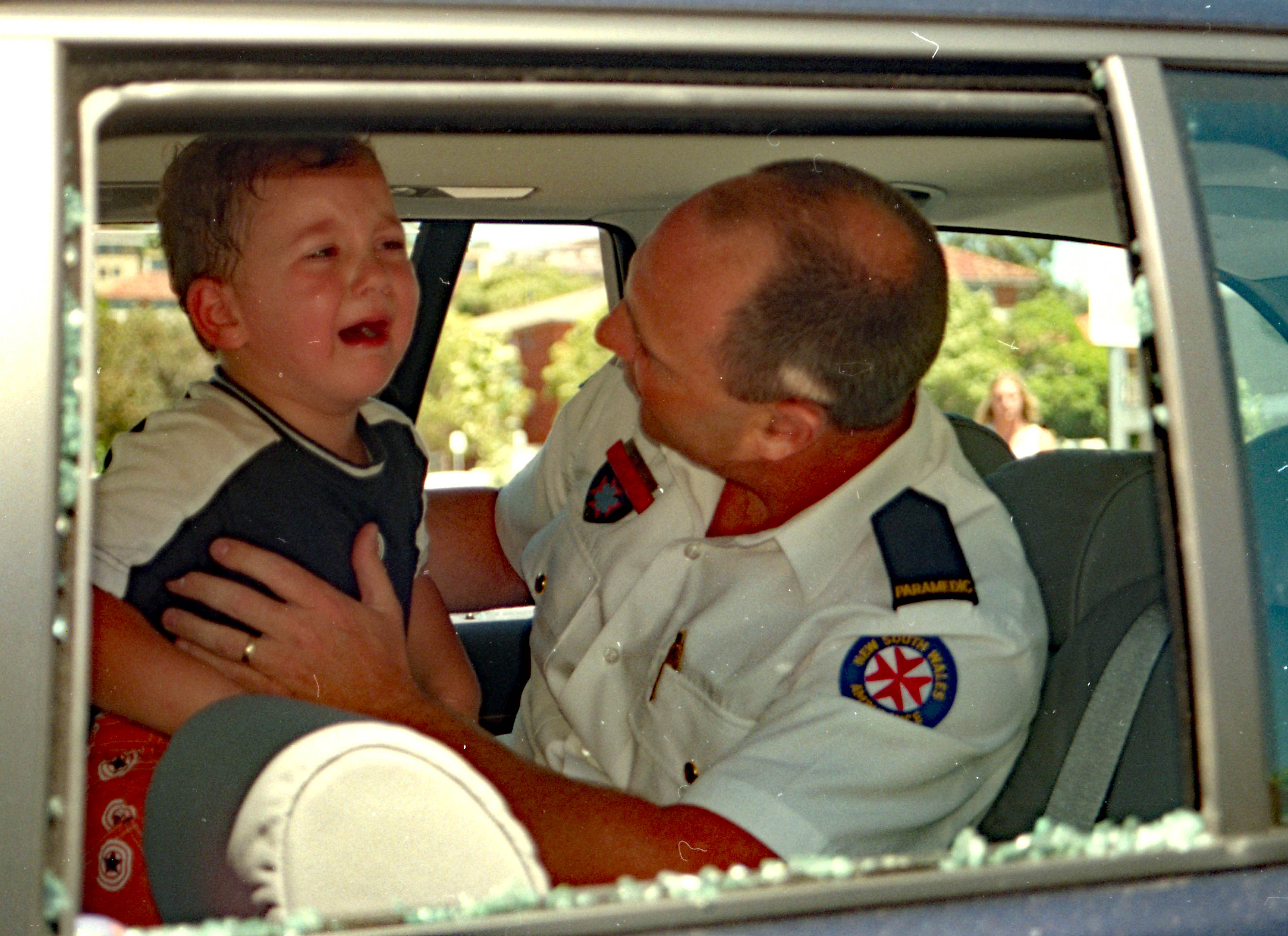
2000, child locked in car at Dee Why. Photo; John Grainger
That ran Front Page around Australia.
And I couldn’t have a by-line – because the paper I was working for was the Weekender and they weren’t coming out for another 3 days.
I couldn’t hold it – there was no way I could hold that picture – so it went all around Australia, they used it in Parliament, it changed the Law, and, that was the day a baby died in Melbourne from being locked in a car while mum went to the casino.
There was another one a Terrey Hills. It was just an innocuous thing I attended – it turned out I got a photo of a child standing in front of his house looking at his front door holding a lady's hand. Inside were both his parents dead from a heroin overdose. He woke up, couldn’t wake them up, and wandered the street. (John’s voice breaking).
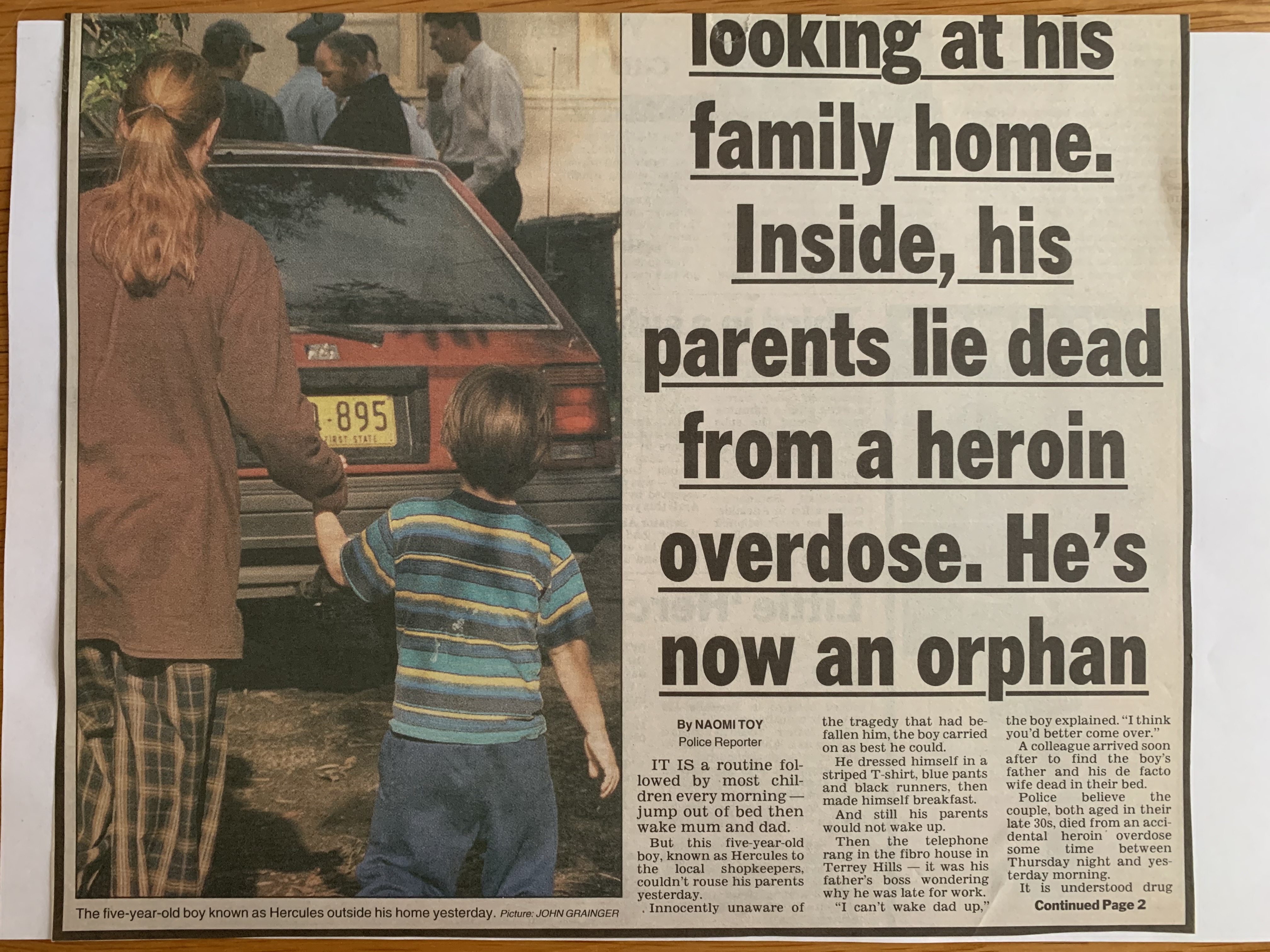
Daily Telegraph, 1999. Mother and father die in front of child. Terry Hills. Photo: John Grainger
In that regard your work has changed laws here, and that reflects back on the attacks you have experienced through doing your job?
What we all say in the media is ‘you watch, those that are always attacking you are the first ones to buy the paper and watch the news’.
Equipment wise – where should someone start?
With whatever they can afford. When I started I upgraded to a Nikon – I started with second-hand gear, whatever you could scrape up. But that changed with digital – these days you could get a good kit, good enough to be published, quite – and with digital it’s become instant.
You have just got to know and have in your mind what is news.
How do you develop that instinct?
I think I was born with it. You know how when you are young you do not give a damn about what your parents do? My mum was a press photographer. (laughs)
You have a history of this then – who is your mum?
Yes – Patricia Grainger. She was back in the black and white days, the 1950’s and this was up in Murwillumbah.
She would have been among the first women press photographers?
Probably was, yes. I’ve only seen one or two of her photos. She and I would spend weekends and days just driving up and down the peninsula looking for stuff. If you knew there was a big swell coming, go to a big spot, and wait, and watch. If there was a protest on, whatever it was – just go and make contact with people and sites that you like. You can get in there that way.
You are not going to get rich. When I started at the Telegraph I think we had over 40 photographers. Then there was a big cull. When I left I think we had 5. It’s a dying thing unfortunately.
If you can nail a job with an agency – people can try agencies and there’s many of those around Sydney, you can get jobs that way. There’s a lot of paparazzi work too.
You are still serving the local community though John, getting and sharing perspectives people don’t get to see. For instance, that photo of the Narrabeen Lagoon entrance works currently underway you shared with Pittwater Online readers opened eyes up even though we’re not a big media company, just a small local news service with a budget of nothing – why are you still doing it?
It doesn’t leave you, you still do it, you still want to. You just learn to control it so it doesn’t take over your life.
If that’s what you want to do, sure, go into it, just be aware of the time involved, the 24/7. I got married throughout the whole thing and I’m surprised I’m still married.
In the old days when I started it was black and white – so I would hear of an accident and go out at midnight or whatever time it was, take the photos, come back, process it in the bathroom, make it up to neg (negatives) and then drop it to the Manly Daily, slip it under their door before dawn, and then go to my normal job. And I wasn’t even working for them.
I went right through the transition form black and white to colour to digital. So you have to keep up what you’re learning as well. We used to send film back by taxi from wherever in Sydney – nowadays it’s just on your phone.
I remember getting films processed at Newport in the 1980’s and having to take on an extra job to pay for the processing – took way too many…
That’s the thing I can’t figure out; why is Murdoch getting rid of photographers when we’re actually saving money now? It doesn’t make sense.
I think there may a different business model to that driving local news services John, different priorities.
Yeah.
Narrabeen Lagoon Entrance Works 2023: Update Pics - Front Page Pittwater Online News, Issue 604
If you had to nominate 3 favourite shots over the almost four decades you have been doing this, what would they be?
Well, there’s a lot there; you could go best hard news, best weather, best fun job.
One of each then?
Well, that baby locked in the car.
Definitely – that changed the law – that is what your work helped accomplish. And?
The funniest, where I laughed the most, would be the kangaroo that hopped across the Harbour Bridge.
That was you that got that?
Yeah. I heard about it driving in and raced to the Harbour Bridge, couldn’t find it, got off the bridge and saw a cop car at the Conservatorium. So I jumped out and there they were, lying on top of a kangaroo.
What happened to that kangaroo?
The police took it away, in a horse float, (laughs out loud) and it went to the zoo and got rehabilitated and then they let hm go – away from the bridge.
And one more?
Weather. Many many weather shots. Narrabeen always pops up. There was a market on one Sunday and I knew something was going to happen – I only carry one camera with a wide lens. This storm built up over the lake. It came across like a hurricane. The photo I got was people holding on to their tents and you could see their feet digging into the ground trying to hold on. Then one flew over Pittwater road and I got the shot – I’ve been holding onto it – and chairs flying by.
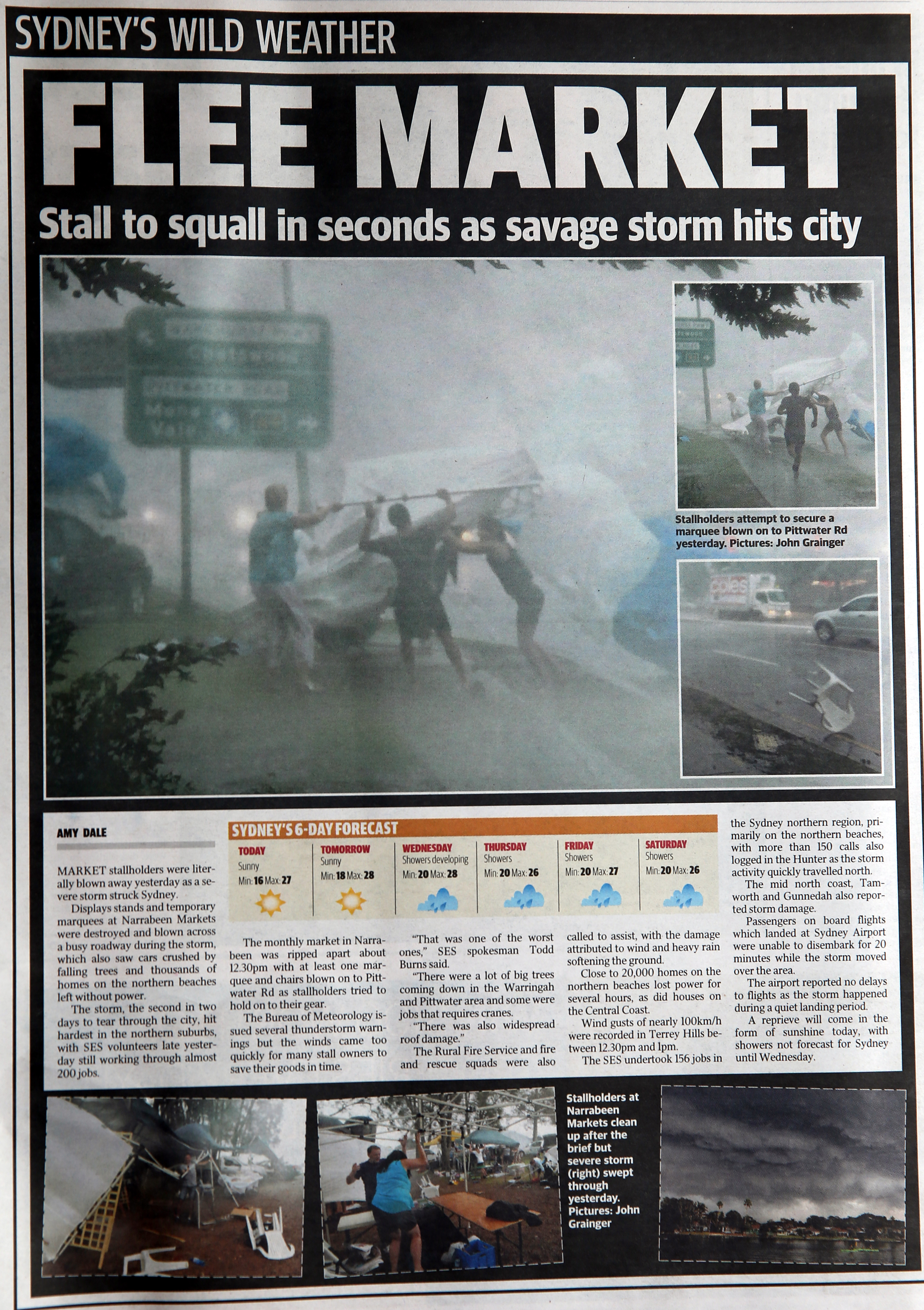
March-17-2014-Daily Telegraph-p9. Photo; John Grainger
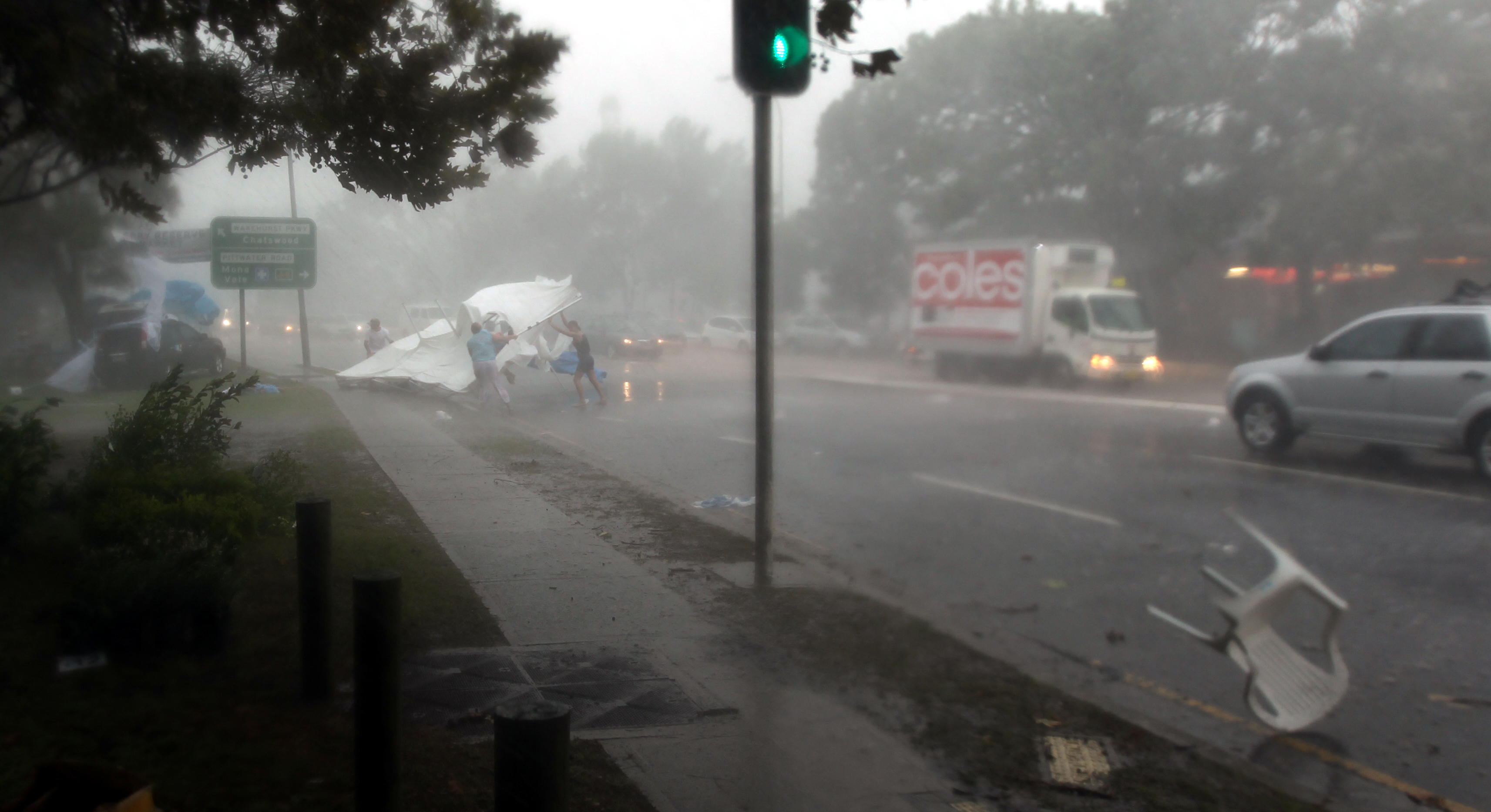
Storm, North Narrabeen 2014. Photo; John Grainger
Just on the local area; you have taken a lot of beautiful nature shots – is that a love of yours?
Oh yes; I might see something when I’m out and I’ll just take the shot. This morning I saw a great shot, I’m now working on a golf course, and so I just take pictures when I’m out because it’s really nice. You see something and you just know it, you think ‘oh that’s nice’.
Another thing I like taking is birds – I used to chase around the osprey (at Narrabeen). I’m always watching them (the birds) down at Narrabeen. And that’s another thing people can do if they want to get into it and get a Pictures Editor to notice them, go and photograph some birds.
What are your favourite places in Pittwater and why?
Narrabeen, because of its diversity. You can go to the lake – the pool is one of the best photographic locations in Sydney really. And you have some of the best surfers in Australia at Narrabeen. Everything is in that one spot, so I always hit Narrabeen.
What is your ‘motto for life’ or a favourite phrase you try to live by?
Go with the flow, whatever’s happening.
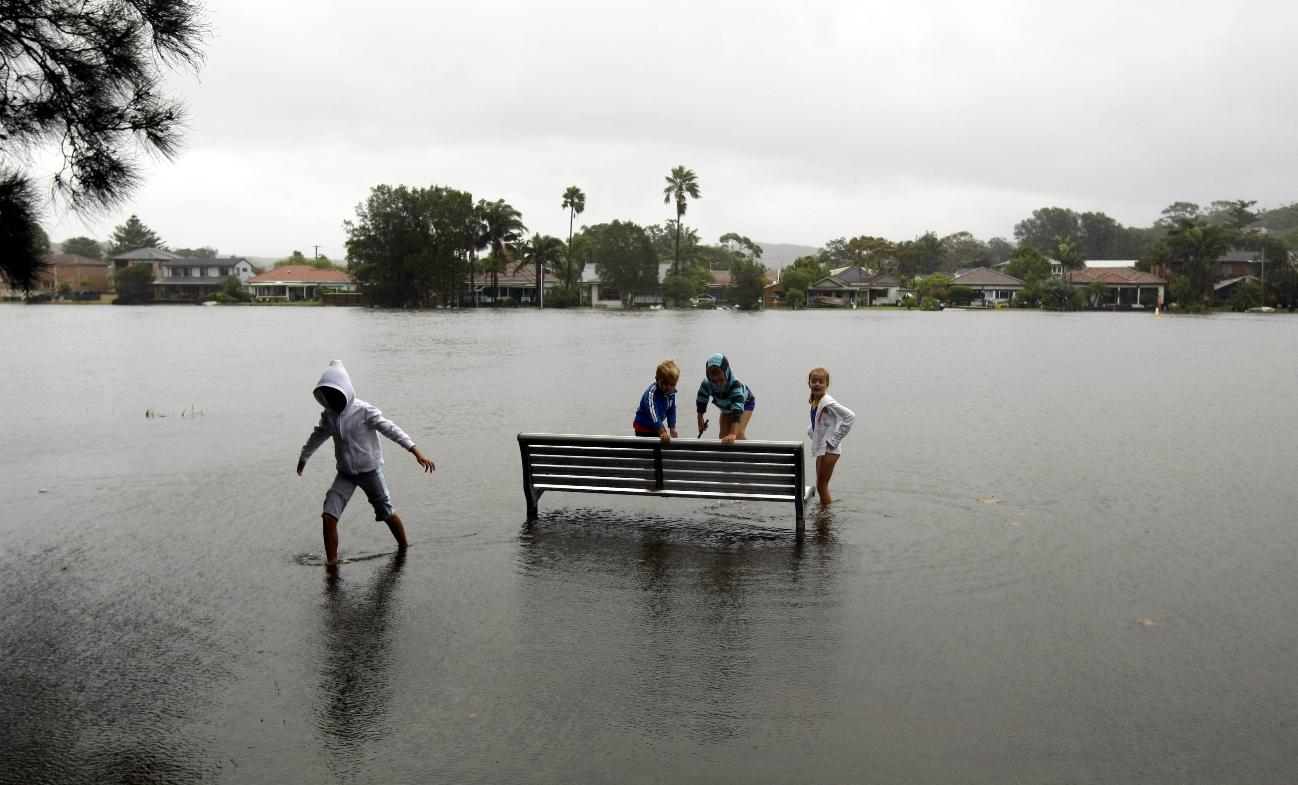
Notes
Australian Press Council
The Council is funded by its member publishers in the newspaper and magazine industries. Government regulation of broadcast media in Australia is conducted by the Australian Communications and Media Authority.
The Australian Press Council (APC) was established in 1976 with the goal of promoting high standards of media practice, community access to information of public interest, and freedom of expression through the media. The Council is the leading industry organisation for responding to complaints about Australian newspapers, magazines and digital outlets.
The APC was established in 1975, at a time when the Federal Government was threatening legislation to create a government authority to ensure press accountability.
In accordance with its Constitution, the Council pursues its goals by:
- considering and dealing with complaints and concerns about material in newspapers, magazines and journals, published either in print or on the internet;
- encouraging and supporting initiatives to address the causes for reader's complaints and concerns;
- keeping under review, and where appropriate, challenging developments which may adversely affect the dissemination of information of public interest and may consequently threaten the public's right to know;
- making representations to governments, public inquiries and other forums as appropriate on matters concerning freedom of speech and access to information;
- undertaking research and consultation on developments in public policy affecting freedom of speech, and promoting;
- promoting an understanding of the roles and activities of the council through forums and consultations; and encouraging feedback for Council's consideration.
Australian Press Council Statement Of Principles
The Council's Statements of Principles are binding on all publications which are subject to its jurisdiction.
The Council's Standards of Practice relating to print and online publishing are contained in the Statement of General Principles and the Statement of Privacy Principles, detailed below.
The Statement of General Principles
Publications are free to publish as they wish by reporting facts and expressing opinions, provided they take reasonable steps to comply with the following Principles and the Council’s other Standards of Practice:
Accuracy and clarity
1. Ensure that factual material in news reports and elsewhere is accurate and not misleading, and is distinguishable from other material such as opinion.
2. Provide a correction or other adequate remedial action if published material is significantly inaccurate or misleading.
Fairness and balance
3. Ensure that factual material is presented with reasonable fairness and balance, and that writers’ expressions of opinion are not based on significantly inaccurate factual material or omission of key facts.
4. Ensure that where material refers adversely to a person, a fair opportunity is given for subsequent publication of a reply if that is reasonably necessary to address a possible breach of General Principle 3.
Privacy and avoidance of harm
5. Avoid intruding on a person’s reasonable expectations of privacy, unless doing so is sufficiently in the public interest.
6. Avoid causing or contributing materially to substantial offence, distress or prejudice, or a substantial risk to health or safety, unless doing so is sufficiently in the public interest.
Integrity and transparency
7. Avoid publishing material which has been gathered by deceptive or unfair means, unless doing so is sufficiently in the public interest.
8. Ensure that conflicts of interests are avoided or adequately disclosed, and that they do not influence published material.
Statement of Privacy Principles
Along with the Statement of General Principles and the Specific Standards, the Privacy Principles are applied by the Council when providing advice or adjudicating on individual complaints.
Privacy Principle 1: Collection of personal information
In seeking personal information, journalists should not unduly intrude on the privacy of individuals and should show respect for the dignity and sensitivity of people encountered in the course of gathering news. In accordance with Principle 7 of the Council's Statement of General Principles, media organisations should take reasonable steps to avoid publishing material which has been gathered by deceptive or unfair means, unless doing so is sufficiently in the public interest. Generally, journalists should identify themselves as such. However, journalists and photographers may at times need to operate surreptitiously to expose crime, significantly antisocial conduct, public deception or some other matter in the public interest. Public figures necessarily sacrifice their right to privacy, where public scrutiny is in the public interest. However, public figures do not forfeit their right to privacy altogether. Intrusion into their right to privacy must be related to their public duties or activities
Privacy Principle 2: Use and disclosure of personal information
Personal information gathered by journalists and photographers should only be used for the purpose for which it was intended. A person who supplies personal information should have a reasonable expectation that it will be used for the purpose for which it was collected. Some personal information, such as addresses or other identifying details, may enable others to intrude on the privacy and safety of individuals who are the subject of news coverage, and their families. To the extent lawful and practicable, a media organisation should only disclose sufficient personal information to identify the persons being reported in the news, so that these risks can be reasonably avoided.
Privacy Principle 3: Quality of personal information
A media organisation should take reasonable steps to ensure that the personal information it collects is accurate, complete and up-to-date.
Privacy Principle 4: Security of personal information
A media organisation should take reasonable steps to ensure that the personal information it holds is protected from misuse, loss, or unauthorised access.
Privacy Principle 5: Anonymity of sources
All persons who provide information to media organisations are entitled to seek anonymity. The identity of confidential sources should not be revealed, and where it is lawful and practicable, a media organisation should ensure that any personal information derived from such sources that it holds does not identify the source.
Privacy Principle 6: Correction, fairness and balance
In accordance with Principle 3 of the Council's Statement of General Principles, media organisations should take reasonable steps to ensure that factual material is presented with Statement of Privacy Principles reasonable fairness and balance, and that writers’ expressions of opinion are not based on significantly inaccurate factual material or omission of key facts. In accordance with Principle 4 of the Council's Statement of General Principles, media organisations should take reasonable steps to ensure that where material refers adversely to a person, a fair opportunity is given for subsequent publication of a reply if that is reasonably necessary to address a possible breach of General Principle 3. A media organisation should take reasonable steps to provide a correction or other adequate remedial action for publishing any personal information that is significantly inaccurate or misleading, in accordance with Principle 2 of the Council's Statement of General Principles. The media organisation should also take steps to correct any of its records containing that personal information, so as to avoid a harmful inaccuracy being repeated.
Privacy Principle 7: Sensitive personal information
In accordance with Principle 6 of the Council's Statement of General Principles, media organisations should take reasonable steps to avoid causing or contributing materially to substantial offence, distress or prejudice, or a substantial risk to health or safety, unless doing so is sufficiently in the public interest. Members of the public caught up in newsworthy events should not be exploited. A victim or bereaved person has the right to refuse or terminate an interview or photographic session at any time. Unless otherwise restricted by law or court order, open court hearings are matters of public record and can be reported by the press. Such reports need to be fair and balanced. They should not identify relatives or friends of people accused or convicted of crime unless the reference to them is necessary for the full, fair and accurate reporting of the crime or subsequent legal proceedings.
The Principles focus on four sets of key values:
The Statements of Principles are interpreted and applied by the Council in response to particular complaints. Along with the Specific Standards, they form the Council's Standards of Practice.
Retrieved from: https://presscouncil.org.au/standards/statement-of-principles
Godfrey Bigot
** Brad Pedersen’s alter ego, Godfrey Bigot stood against Ellis and Bishop in Mackellar in the 1993 Federal election. Bigot, who described himself as "a demolition entrepreneur specialising in heritage buildings" was then the patron of the Koala Shooters Party. Godfrey Bigot is a satirical character who pretended to represent environmental destroyers and extremists.
Brad Pederson was an independent councillor at Manly, previously the Deputy Mayor of Manly and president of Democracy Watch, Australians for Political Funding Reforms.
In 1999 'Bigot' stood for the People Before Party Politics party. While he was very successful in local politics, he did not have quite the same appeal across the State.
In January 2020, as bushfires raged across NSW killing billions of animals, a photo of Mr. Pedersen lying down out the front of the Sydney News Corp headquarters went viral.
A self-described “humble citizen who just wants to lie in Rupert’s gutter”, Pedersen took the solo protest action at the Holt Street offices in Surry Hills, because the Murdoch press has been lying to the Australian public for decades.
Spurred on by the response to his initial social media splash, Mr Pedersen organised the 'Murdoch News Corp Lie-In Protest', which drew an impressive line-up of speakers and supporters, all calling for an end to Murdoch’s media manipulation and monopolisation. “They Lie All the Time”: An Interview With the News Corp Lie-In’s Brad Pedersen, 04/02/2020 BY PAUL GREGOIRE available at: https://www.sydneycriminallawyers.com.au/blog/they-lie-all-the-time-an-interview-with-the-news-corp-lie-ins-brad-pedersen/
Narrabeen Man
The Narrabeen Man was found by contractors digging for electricity cables near the corners of Octavia Street and Ocean Street, Narrabeen. A forensic investigation was undertaken and bone samples were sent to Lawrence Livermore National Laboratory in California to determine the age of the remains. Radiocarbon dating of the bone suggested an age of around 14,000 years for the skeleton. The Narrabeen man was suspected to be 30–40 years old when he died. This is recorded to be Sydney's oldest skeleton and is Australia's third oldest skeletal remains behind Mungo Man and Mungo Lady.
An archaeological dig at the site revealed that Narrabeen Man was found in a posture unlike a tribal ceremonial burial. Rather than lying on his front with hands by the side or across the chest, the Narrabeen Man was on his side with one arm across his head. Further investigation of the skeletal remains revealed evidence of spear ends found embedded into his vertebrae and near other parts of the body. This indicated death by spearing and suggested to archaeologist Dr Jo McDonald that Narrabeen Man was perhaps the first physical evidence of ritual murder in Australia.
Further examination revealed that Narrabeen Man was approximately 183 cm tall, estimated from the length of his limbs,[6] 30–40 years old. His height was above average for Aboriginal men at this time. It is also speculated that Narrabeen Man was not from a tribe from the greater Sydney region, as his two front teeth were not removed - in line with a regional initiation rite at the time of European settlement (unless the rite was introduced locally in more recent times than Narrabeen Man's demise).
There is no conclusive evidence as to why he was killed. A Narrabeen cultural heritage officer, Allen Madden, suggested in 2008 that a ritualistic murder of this type represents the farthest extent of tribal law, indicating that his offence, whatever it was, must have been serious.
Narrabeen Man's remains are currently lying under care at Sydney University's Shellshear Museum.
Australia's First Independent Newspaper
The Hobart Town Gazette was established by Andrew Bent in 1816 in Hobart, Van Diemen's Land (known as Tasmania since 1856) as The Hobart Town Gazette and Southern Reporter. In 1821 the name was changed to the Hobart Town Gazette and Van Diemen's Land Advertiser. In 1825 the title was split, with the government authorised publication remaining the Hobart Town Gazette, and the original editor launching the Colonial Times, and Tasmanian Advertiser. From 1882 it was known as the Hobart Gazette and from 1907 as the Tasmanian Government Gazette.
Andrew Bent kept publishing his newspaper and was given permission to do so from the New South Wales Governor. But Van Diemen’s Land (Tasmanian) officials tried to close his newspaper, arrested him four times for stories he had published, and even imprisoned him. Despite this, the beginnings of a free press had taken root in Australia.
